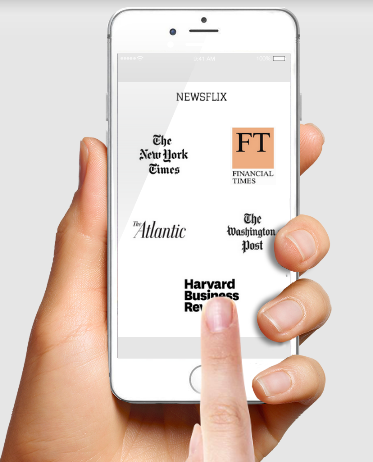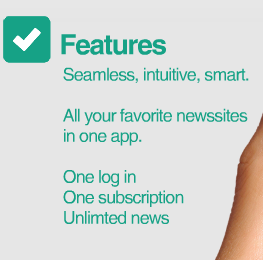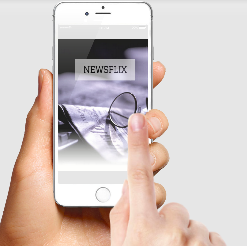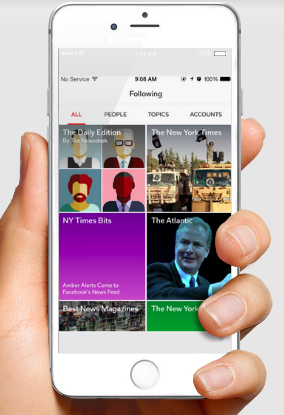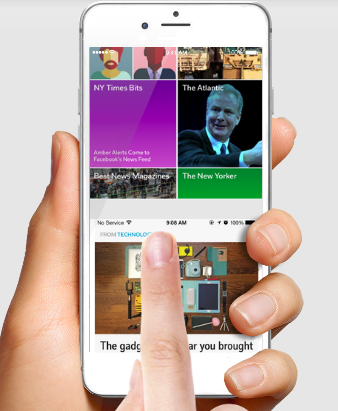NewsFlix
I recently enrolled in Product Management Immersive at General Assembly. The 10-week intensive program explores the pathway and execution methods from idea to product, following the best practices and methodologies.
During our first week we were encouraged to come up with a startup idea, typically a website or an app (technology service). Our main focus was to use our newly acquired skills of agile, customer discovery, user research, wireframing, prototyping and MVPs.
Product/solution:
NewsFlix is a news app with an all-in-one payment solution that enables access to recognized news sites premium subscription content.
The app eliminates the issue of managing multiple premium news subscription accounts and streamlines people's daily news consumption and payment process by adding multiple sources to one application. It also makes your daily news personal and beautifully accessible in one app. Articles will be pulled into the app and sorted on topics, news sources or stories based on user preferences.
Problem hypothesis and assumptions:
People read a lot of news and are faced with a daily information overload. They access news mostly via social media, push notifications from downloaded apps and by accessing favorite news sites. Most of the world’s high quality and reliable news sites offer only a selection of articles per month to read unless users pay for a premium subscription. If users choose to subscribe to multiple sites, they have to manage multiple accounts, passwords and payments.
In order to consume the content from the sites they subscribe to they must visit the respected sources sites individually or access their sources branded apps on their phone.
Assumptions/biases:
Users pay for their news by viewing online advertisements. As more and more news sites resort to digital advertising business models, the user experience is deluded and intruded by excessive banner, pop-up and sidebar ads. In some cases it can be hard to distinguish between advertising and editorial content. My assumption is that people find advertising enough of a hassle that they will pay to remove it.
As the founder I am biased because I have a background in journalism and I consume a lot of news on a daily basis. I also subscribe to multiple news sites premium subscriptions and find managing them a hassle. I may be projecting my problem on to other people. I also get my news in apps and consume most of my news via phone. Statistics show that we are adapting entirely to mobile and want the most amount of convenience. I personally know multiple high income and highly educated people who would want an application like this. However, this market may be smaller than expected and may prove not to be financially viable.
Why Media Houses will buy-in
News outlets globally are suffering as their dated business models of print isn’t paying off anymore.Journalists are losing jobs
Journalists are losing jobs and as a result there are less resources available to invest in investigative journalism and high quality feature articles.
Most news sites are operating under the freemium model. 20% of the users (the premium subscribers) pay for 80% of the freeloaders. They are experimenting with new business models in order to attract more revenue and profit long-term. They find it challenging to find users that are willing to pay for premium content.
NewsFlix would be a viable solution as they would get a small cut of the aggregated payment. All though the amount would not be as much as if they were individual subscribers it will ultimately add more profit to the organization as well as attract new and “right” readers.
Competitive landscape:
Flipboard, branded news sites apps, Digg, Stellar, Circa
Target Audience:
Highly educated, high- income individuals between 25-40 years. Data proves that higher education and income levels are correlated with higher news readership.
Will initially include: The Atlantic, The Harvard Business Review, The New York Times, The Financial Times, The Washington Post, The Wall Street Journal. These are among the most credible news sources in the US and have loyal readerships and a significant amount of subscribers.
Next steps:
- Pitch opportunities to Media Houses
- Build and launch MVP to earlyvangelists
- Talk to investors
Going forward the app will also allow for people to log in through a NewsFlix API on the external participating news sites also giving them full access to their content.
As more readers subscribe, it is suspected that other News Sites will wish to participate as well to get a piece of the pie.
Metrics and Measurements:
- growth
- reader retainment
- Media Outlets participation and interest
- Increased subscription growth for media houses
Customer Discovery:
Interviewing target audience at UN Headquarters in New York.
The majority of subjects were heavy news
Most of the subjects were enticed by the idea of having a one-size fits all subscription model. However, it became clear that this was a strong preference for high-income subjects, and not one for low-income subjects (their argument was that news is free enough places for it not to be worth it). This validated my hunch that this product will be marketed and accepted by a niche audience
However, this may be counterproductive for the news sites that already have these subscribers and who would not make that much more money by lowering their price and losing their existing full-price paying subscribers to the other model.
Therefore, plan B could be to build an app in which premium news subscribers could manage all their premium content in one app, and also provide their credit card information in order to purchase other news site subscriptions with one click from within the app.
This would be an application that would appeal to a niche high-end market, but not attract the big bulks of users.
However, it is worth noting that Netflix and Spotify have massively succeeded with similar models among the public and that people generally tend to bend for convenience and ease of use.
Conclusion: Proceed with MVP.



